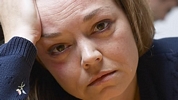"I just got all around the music and let it get all around me.” This is the way Lorna Smith, a resident at Hazel I. Findlay Country Manor in Saint Johns, Michigan, described her experience during one of the regular music therapy sessions offered by music therapist and gerontologist Dr. Stephen Hale.
The program facilitates long-term care for residents who suffer from Alzheimer’s and other severe dementia-causing disorders. Like Smith, many of these residents, who daily battle against decreasing levels of cognitive functioning, perk up immediately as soon as Dr. Hale starts to strum his guitar. Suddenly animated, many of them begin to laugh and smile, clapping and nodding their heads in time to the rhythm. While many residents typically have trouble maintaining focus and remaining alert, as soon as Dr. Hale begins a music therapy session they make eye contact with him easily. When the music starts, their former listlessness and agitation quickly disappears.
"Music therapy in a long-term care setting has a particular value for residents who become isolated, withdrawn and depressed," says Vicki Ritz, the program’s director of nursing.
Alzheimer’s patients are not the only ones whose lives have been significantly improved by music, art, and dance therapy. The treatment has been shown to benefit people suffering from a wide range of disorders, including schizophrenia, aphasia, autism, Tourette Syndrome, and Parkinson’s disease.
Elaine Hall, who adopted her autistic son, Neal, from a Russian orphanage when he was 2-years-old, has made it her mission to bring art therapy to children who have difficulty expressing themselves.
“I wanted to teach theater and dance to kids with autism, cerebral palsy,” attention-deficit disorder, obsessive-compulsive disorder and Tourette syndrome, she said, “anything that gets somebody kicked out of everywhere else.”
Hall, who has been dubbed “the child whisperer” because of her knack for engaging children in performance, founded the Miracle Project as a way to carry out her mission. Formerly an acting coach for Hollywood film and television stars, Hall now prefers to focus her attention on the very young. The Mircale Project, “a musical theater and video arts program for children of all abilities celebrating music, dance, story and culture,” produced a documentary called “Autism: The Musical” that HBO released in 2008. The film chronicles the struggles of a group of autistic children and their families as they get ready to put on a show.
“The first 11 weeks were so chaotic, kids were literally hiding under tables and spinning around in circles,” Hall recalls, then whispers: “Then all of a sudden they start coming together as a group. We wrote a play. We learned songs. We wore costumes. We no longer talked about Steven hiding under tables. We we’re saying, ‘O.K., what role do you think Steven should play?’ ”
Today, as many as seventy universities across the country offer arts therapy programs. Once considered a dubious science at best, expressive arts therapy is now understood to be an important tool in the therapeutic process. Many researchers believe that this is due in large part to the neurological effects of music and dance. Rhythm stimulates activity in parts of the brain that control cognitive function. By promoting communication and facilitating the development of motor skills and synaptic reorganization, music and dance therapy can foster rehabilitation after a stroke or severe brain injury.
Music therapy is also proven to produce calming effects on the body and mind, slowing blood pressure and decreasing heart rate, blood pressure, depression, and anxiety. Because emotional wellbeing plays an important part in overall healing, expressive arts therapy is likewise an important part of the healing process. Dancing and making art and music also have a social impact that helps individuals to feel confident to express themselves and connect with others around them. Music therapists call this the “ripple effect,” a term coined by Mercedes Pavlicevic and Gary Ansdell to describe music’s ability to naturally attract people and create larger social contexts.
Dr. Mike Crawford, professor of Psychological Medicine at Imperial College, who studies the medical effects of creative therapies, says that at times when patients are struggling with illness they “may find it difficult to express themselves using words, but through the skill of the therapist it may be possible to help people interact…in a way that is constructive, creative and enjoyable.”
Whether battling illness or not, just about anyone can benefit from the transformative power of art.



